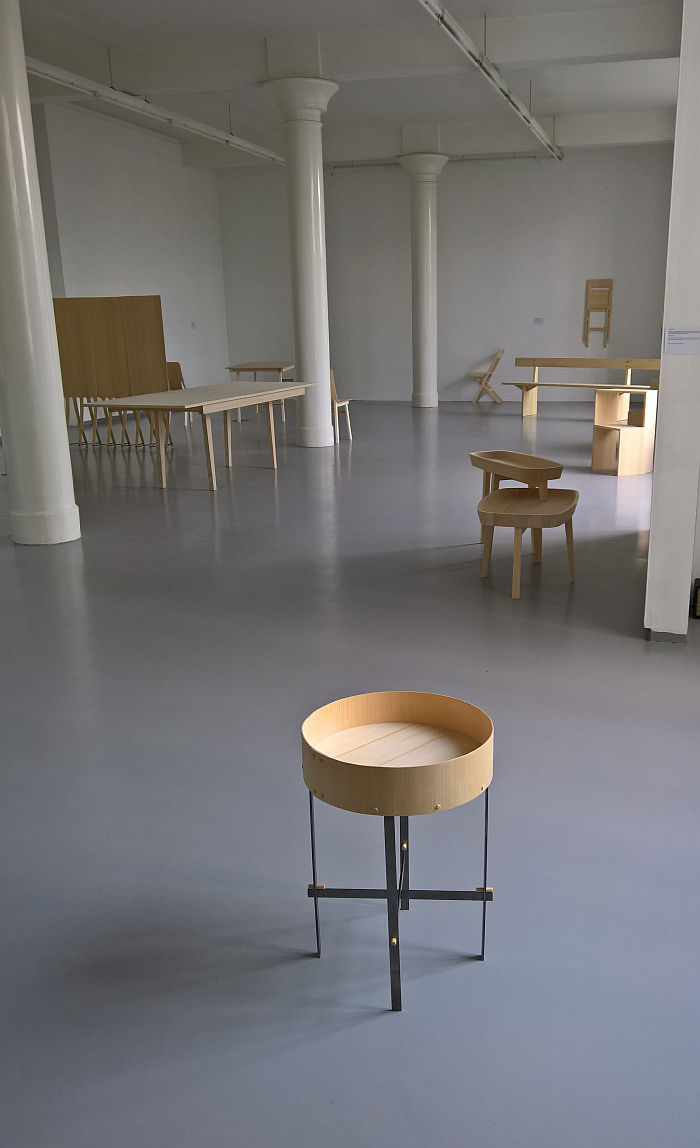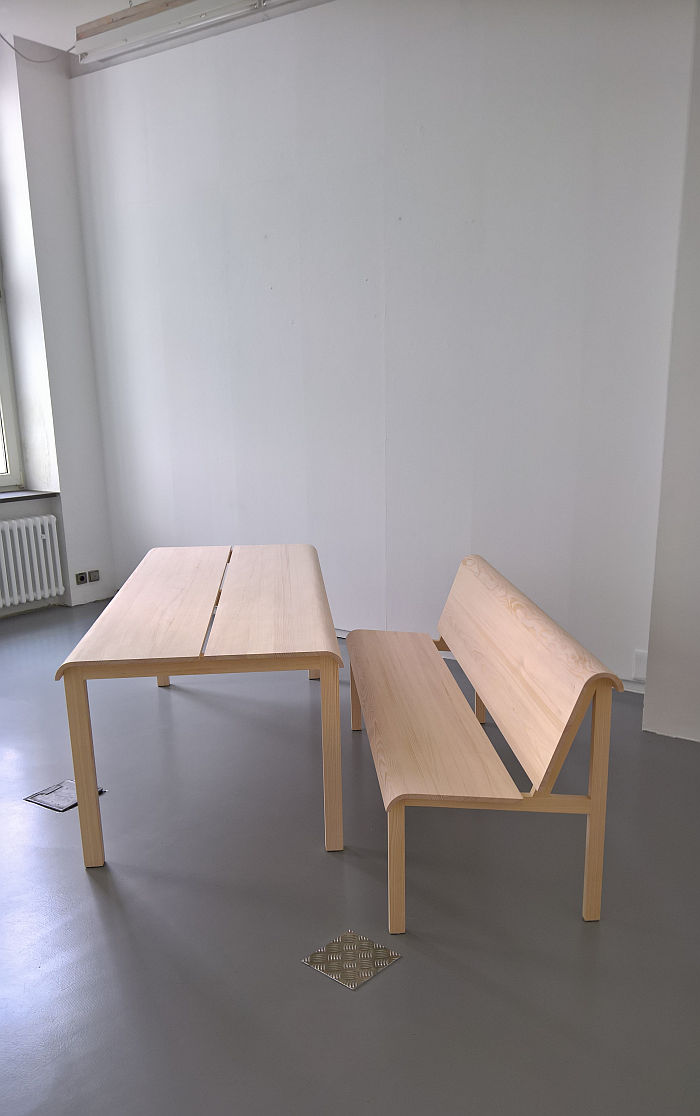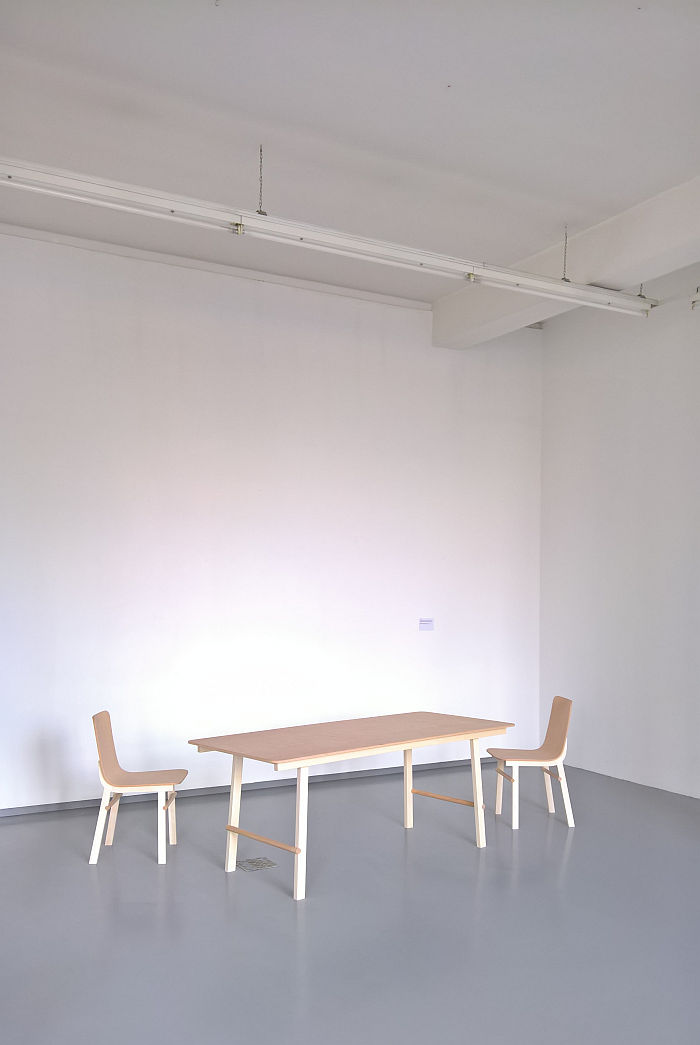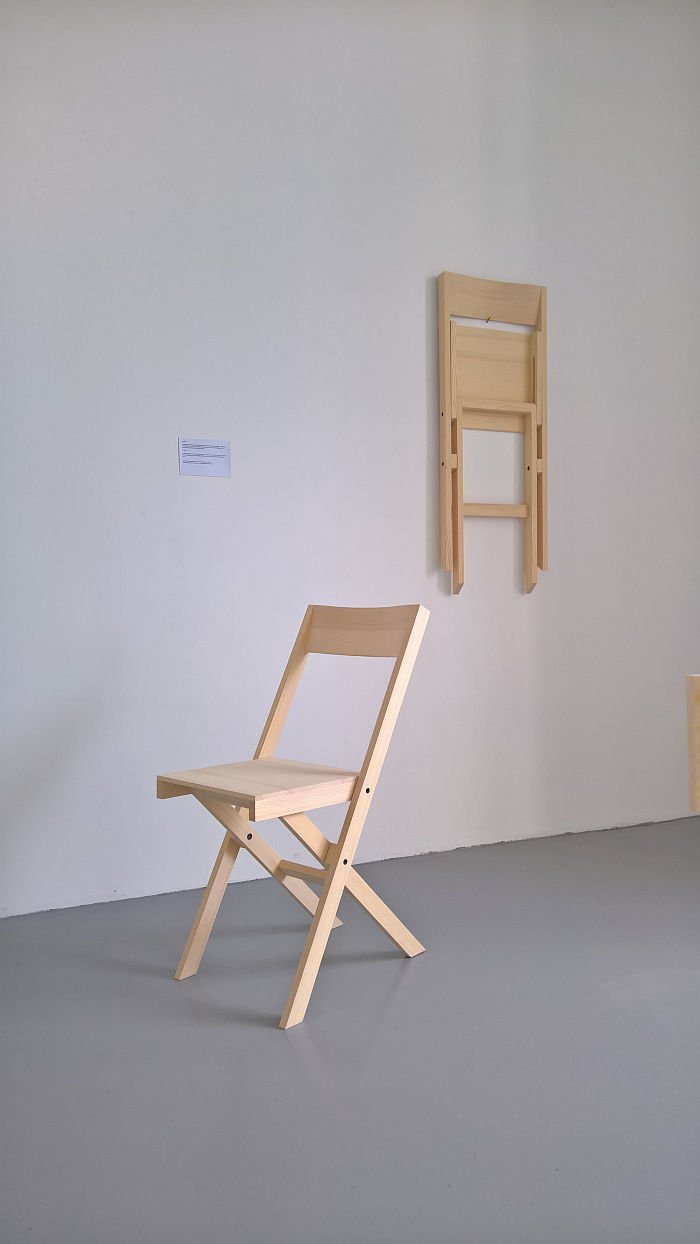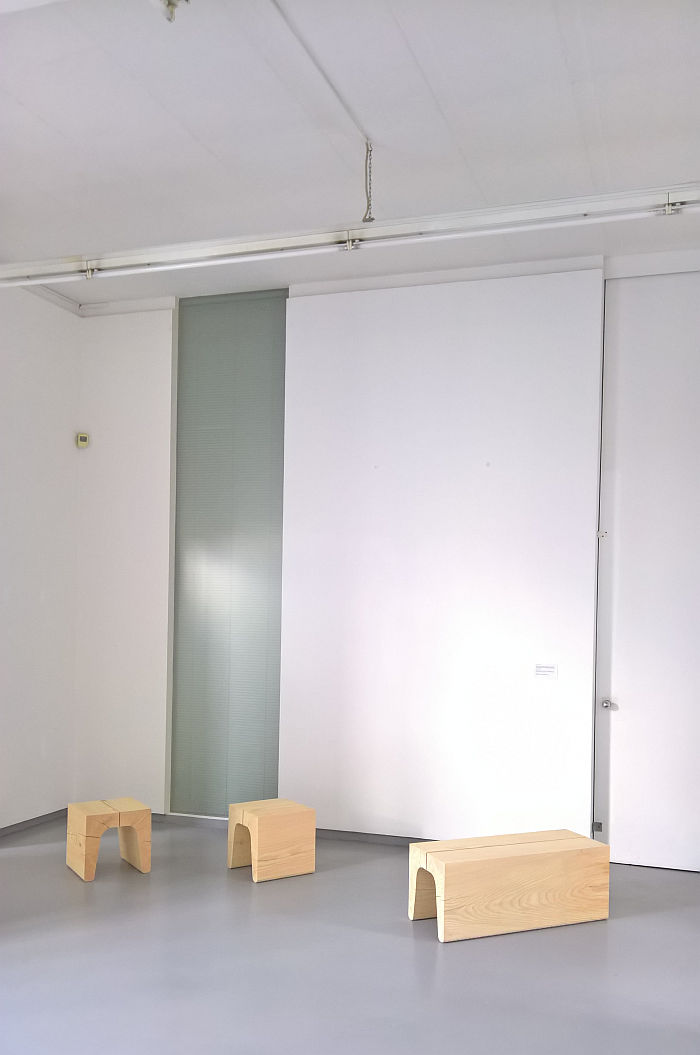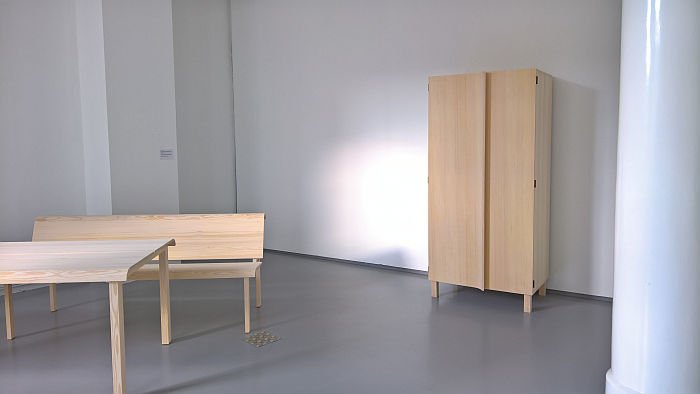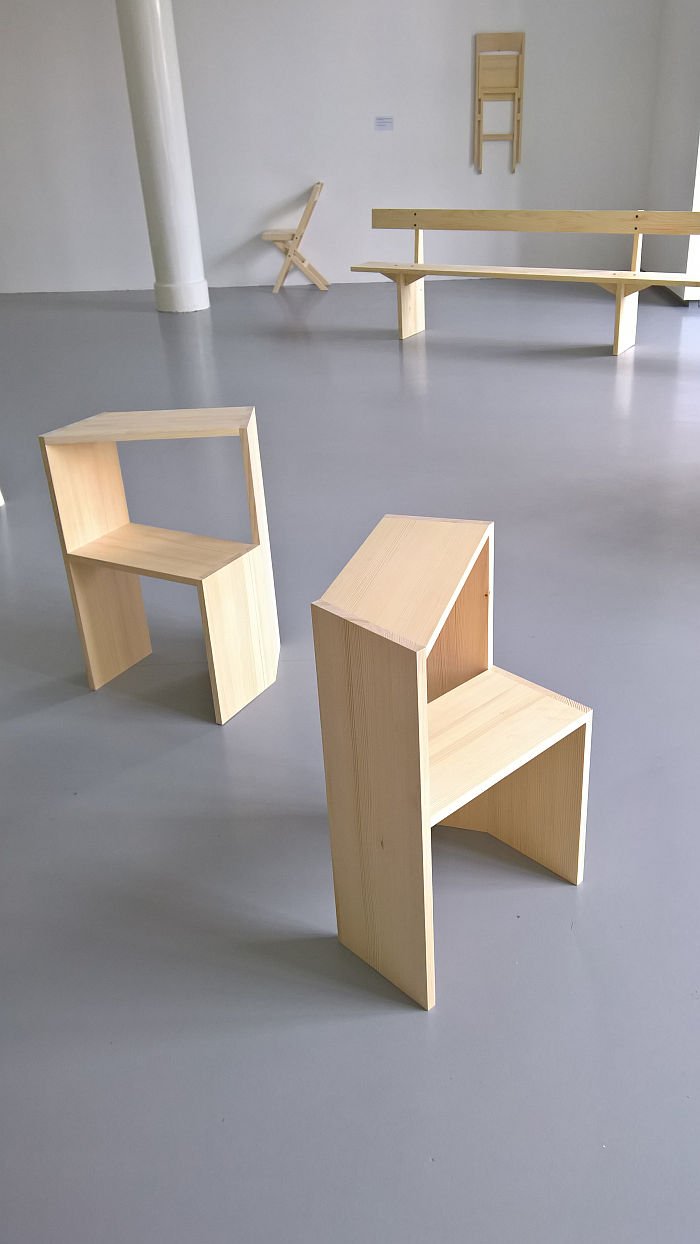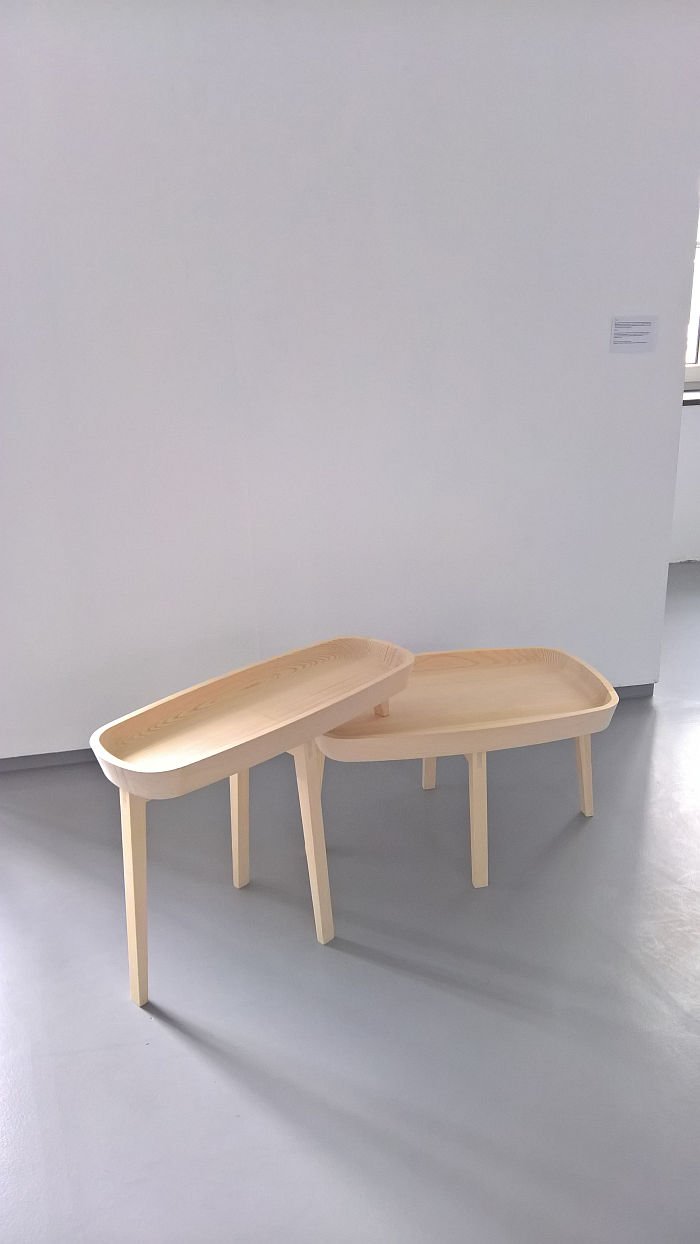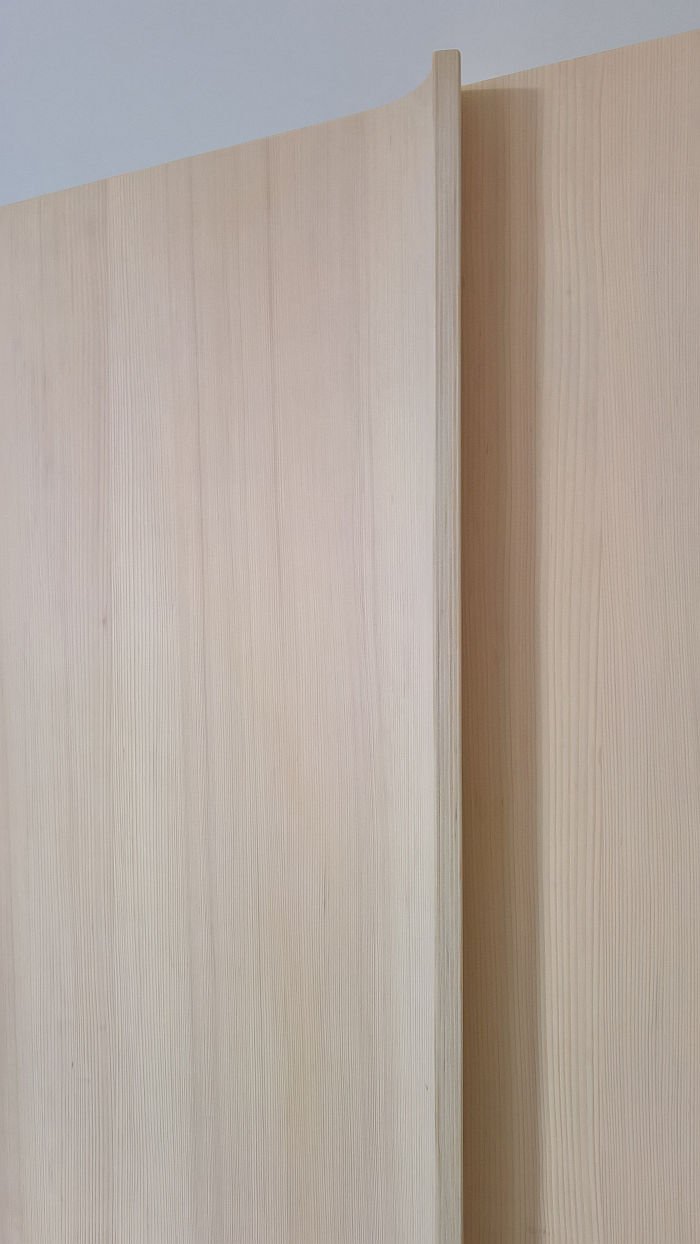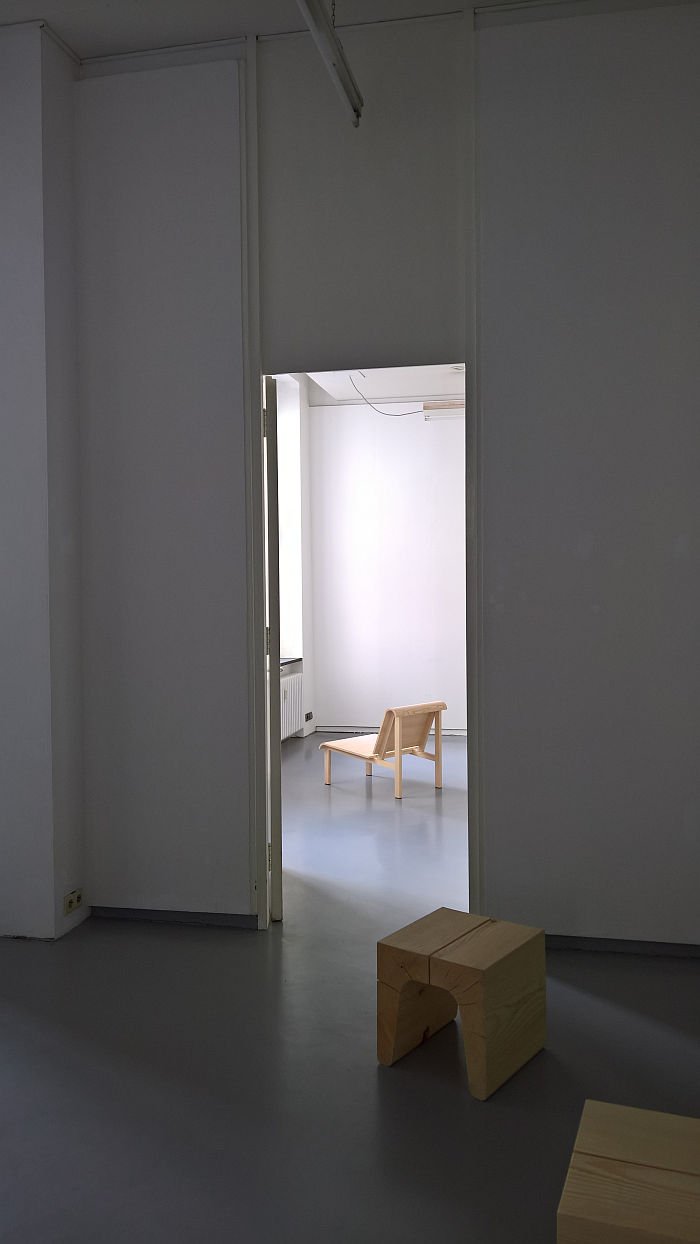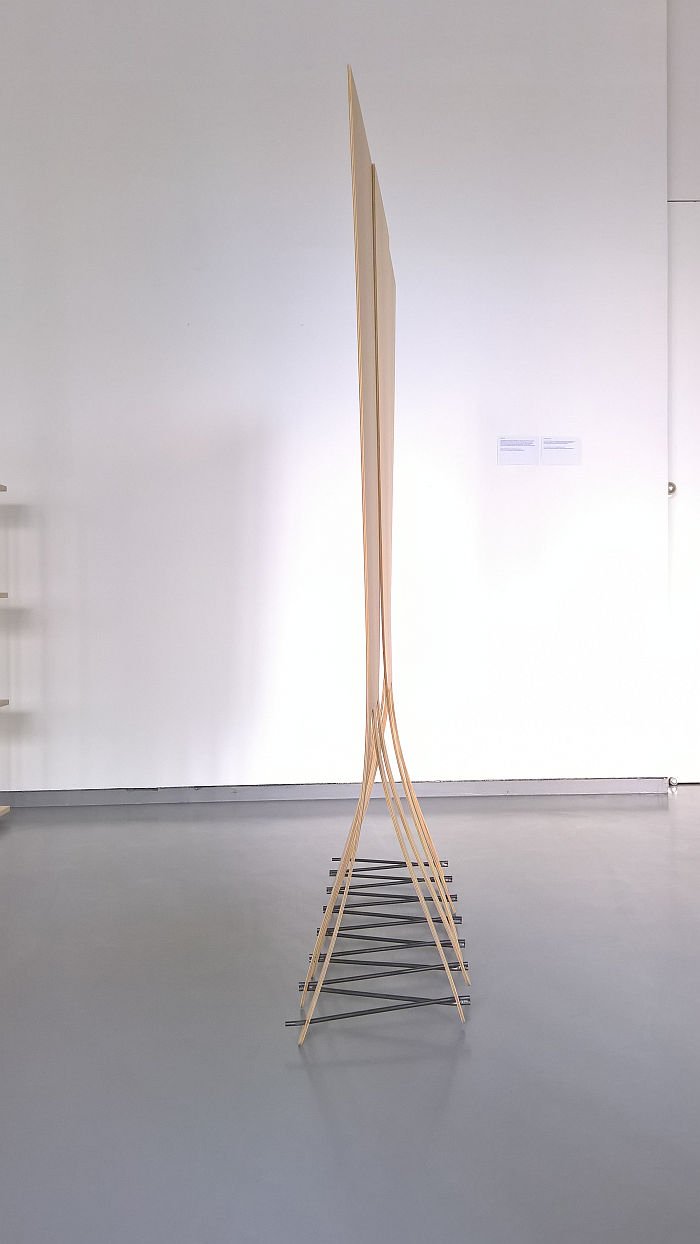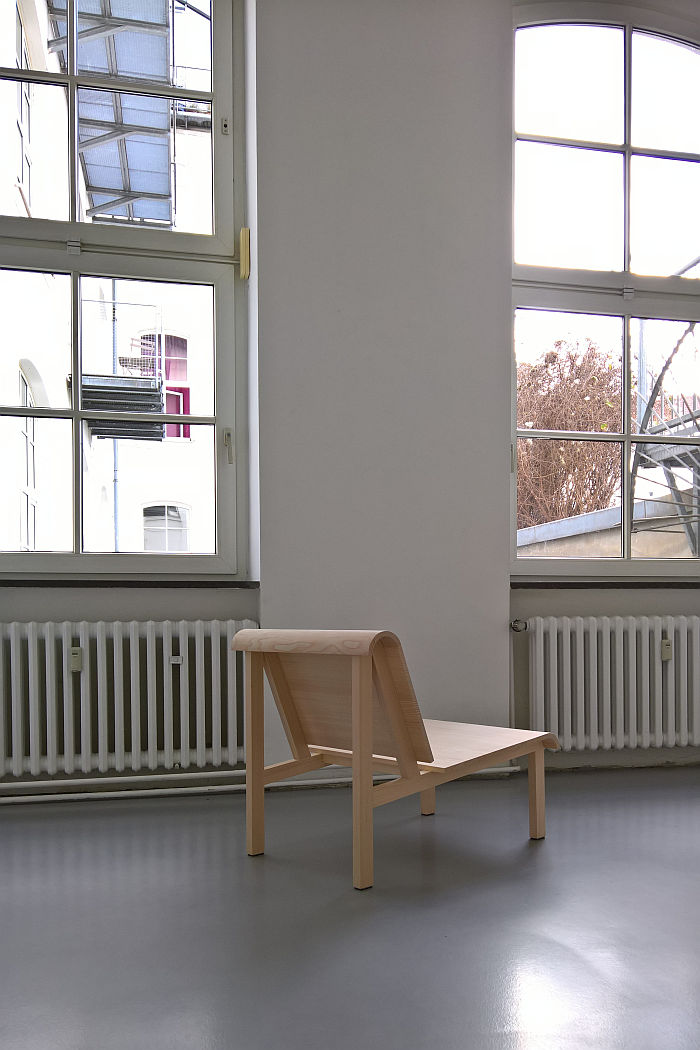In our post from the exhibition Design Gruppe Pentagon at the Museum Angewandte Kunst Cologne we noted that Gallery Pentagon was laterally based in Cologne's Bismarckstrasse. Bismarckstrasse 50 to be precise, a former cardboard packaging factory which in the 1980s was developed into spaces for creatives of various ilks.....
.....Bismarckstrasse 50 is still home to creatives of various ilks, and is still home to a gallery, Galerie Martina Kaiser, where in context of the 2020 Passagen Interior Design Week a new generation of Cologne designers are presenting new projects, projects raised not in the agitations, turmoils and transformations of 1980s West Germany that informed the Pentagonia's works, but rather in the calm, alpine forests of Austria's Bregenzerwald.
Yet objects no less expressive for the change of air.......
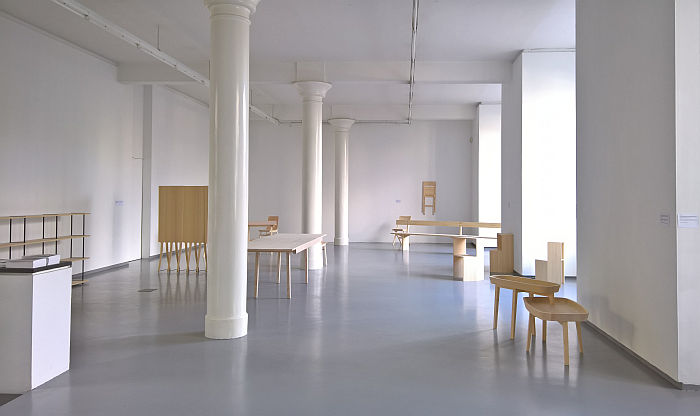
Originating in context of the German/Dutch design project Maken/Machen, and premiering at Dutch Design Week 2017, Generation Köln shouldn't be confused for a formal group, far less a collective, but much more is a platform for presenting some of Cologne's local designers, or localish designers, designers with a connection to Cologne, and which in its current, and most recent, incarnation features Karoline Fesser, Klemens Grund, Tim Kerp and Thomas Schnur. A quartet who for the 2019 Generation Köln project cooperated with carpentry businesses in Austria's Bregenzerwald, Bregenz Forest.
Rising from the south-eastern end of Lake Constance ever upwards into the foothills of the Austrian Alps, the Bregenzerwald is a region that not so much has a long wood craft tradition but a region that has developed hand in hand with its wood craft tradition, and whose wood craft tradition has developed hand in hand with the region. And thus a region with a depth, length and breadth of innate, inherent, experience in and understanding of wood and wood construction which makes it a logical and interesting location for designers seeking not only new impulses and insights, but also seeking to further develop their understanding of materials, processes and constructions.
And while the suspicion that undertaking a project with carpenters in the Bregenzerwald may have incentives beyond craft, design and furniture is, more or less, confirmed by the holiday photos on show in the exhibition space, work was also undertaken. Work which resulted is some 12 projects developed in various designer/carpenter combinations and which present themselves in Galerie Martina Kaiser as a unified, harmonious, group, a unity/harmony that isn't exclusively related to the fact the dozen works are created (almost) exclusively in Weißtanne, silver fir, that tree and wood that defines and is so important to the Bregenzerwald .... even if the prevalence of silver fir is the most obvious unifying and harmonious note.
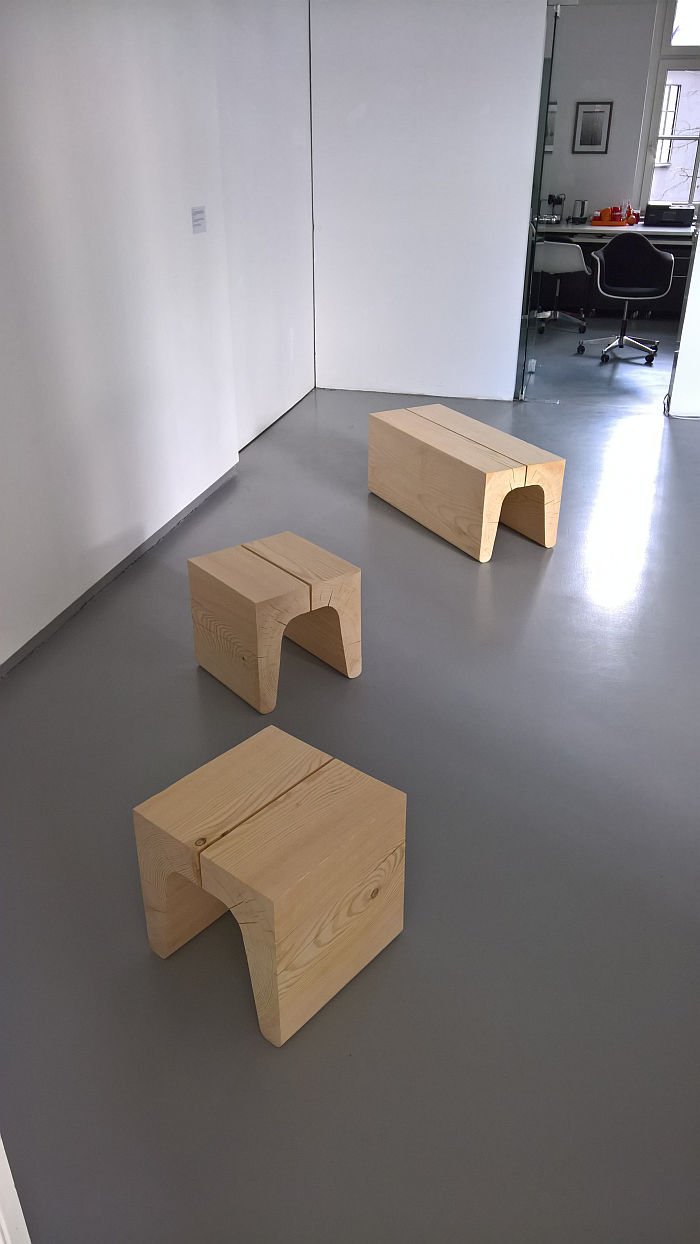
If one that is only obvious in freshly finished, untreated, objects such as those on show in Generation Köln trifft Bregenzerwald; as a wood silver fir, like us all, greys with age, a fact attested to by the innumerable images in the holiday slide projection of the silver fir shingles that traditionally grace the facades of buildings in the Bregenzerwald, silver fir shingles in a cornucopia of greys, a patina that not only testifies to the durability of silver fir as a material but allows you to grow old, to grey, in harmony with your silver fir furniture. And a process, more or less actively sought in the U Stool/Bench by Karoline Fesser in cooperation with carpenter Harald Berchtold.
Crafted from two half-Us joined by dowels to create a whole, if upturned, U, a ∩, a mathematical intersection, which it could be considered, containing as it does elements of Karoline and elements of Harald, the U Stool/Bench is an approachable yet assertive object, one with a primeval character that belies the contemporaneousness, an object which carries its dowels, the exposure of its construction, with a self-assurance that makes you question why other objects seek to hide their construction, and an object/objects which all logic dictates should be dispatched outside to play and weather. However we'd argue would have no objections to being inside, where they could, should?, still express themselves fully while ageing more gradually.
Aside from it's predilection to greying silver fir has a couple of more practical advantages in context of furniture production, advantages neatly demonstrated in Generation Köln trifft Bregenzerwald.
On the one hand the heights silver firs reach, or at least when left to grow naturally and not in the controlled, stunting, atmosphere of a plantation, and thus the length of planks that can be hewn, something employed and underscored by both Thomas Schnur and Klemens Grund, the latter in the brut fir shelving system developed with Martin Bereute, a shelving system which employs a stupidly simple and stupidly efficient locking system to not only ensure stability but also ensure an optimal load bearing capacity of the individual shelves, and thus ensuring not only the longevity of the system but allowing for an ease of assembly, disassembly and reassembly that contradicts its scale. Thomas Schnur employing the length of planks the silver fir offers in his unnamed bench, a reduced interpretation of the church pew, an object which despite its length is anything but imposing, rather communicating in gentle considered tones, something aided and abetted by the open, honest, almost humble construction system. And a work which as much as being a seating object is also reflections on contemporary relationships to the church, and on the possibilities of creating that idea of community that is as much the function of a house of worship as religious celebration, in other locations. Such as a gallery. Which is also a space where one can, should, sit and reflect on life, the universe and everything.
And thus the sort of abstract conceptional thoughts designers today can entertain on account of the legacy of those who once occupied gallery spaces such as Bismarckstrasse 50. We all being but points on an ever forward twisting, turning, continuum.
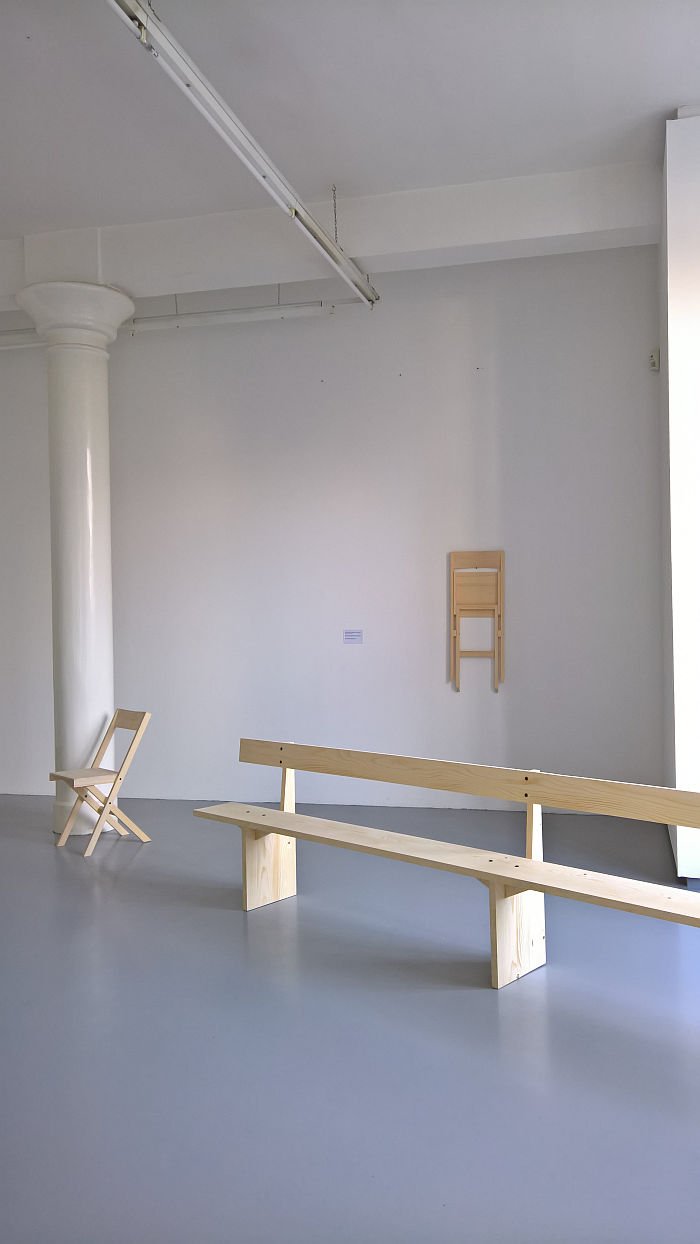
A second attribute of silver fir wood, and arguably one related to the ridiculous heights the silver fir tree grows, is the relative lack of knots one gets; a lack of knots which on the one hand helps improve the wood's stability and strength, for all when used at the lengths employed in brut fir or Thomas's bench, and on the other means an easily achieved knot-free visual, something observable in the solid wood components of Karoline Fesser and Wolfgang Meusburger's Layer Cabinet or Klemens Grund and Valentin Winder's extendable table: a table which extends via a very satisfyingly analogue, 100% wood, system.
For his siti table, created together with Wolfgang Schmidinger, Klemens opted for a beech plywood table top, a decision which on the one hand reflects the round beech leg stretchers and equally serves as a decorative contrast to the silver fir frame, but also reflects and comments the use of beech plywood for the shell of the siti chair; a moulded beech shell with an nicely curved, and supportive, backrest and a moulded beech shell which sits, snugly in, and is securely held by, a pair of cupped silver fir braces. The result being not only a pleasing visual composition and equally pleasing sitting experience, but a very light chair.
Lightness being a further inherent property of silver fir.
And one also elegantly exemplified in Stufen by Thomas Schnur and Martin Bereuter, an intelligently formed and constructed object which we're claiming as a library step, complete with that all important space for perching to peruse your retrieved tome, but which is equally applicable as a general home/office step. And which Thomas also pitches as sofa/bedside table, and which with its nice split-level storage option, we'll happily buy into. And a lightness also elegantly exemplified in the Klapp folding chair realised by Thomas with Valentin Winder and weighing in at just 2.4 kilos. Or perhaps better put, not weighing in at 2.4 kilos. And not only a physically light work but a formally and constructionally light work: a charmingly compact, minimised object which despite its material brevity provides for an excellent level of seating comfort, thanks in no small part to the intelligently formed backrest, and which features a folding mechanism that is super light.... as in foolproof. Even we managed it. By ourselves.
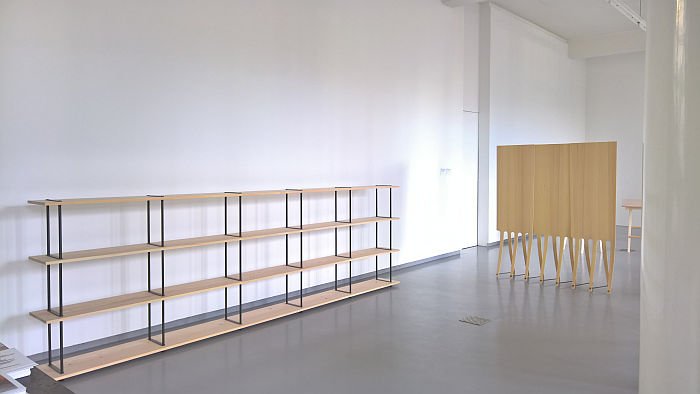
Beyond the direct influence of the material and the expertise of the carpenter it is inherent in the nature of such projects, projects in which travellers from one location are immersed in the culture and practices of another, that ideas arise locally, that local impressions upon the travellers find their ways into their works, and in context of Generation Köln trifft Bregenzerwald the Readymade Award goes to Tim Kerp for the side-tables Trog and Say Cheese.
The former developed together with Wolfang Meusburger and inspired by the traditional wooden water troughs of the region, for all those used for watering livestock, and which as an ensemble can be freely combined to create an object appropriate for the space. Aside from Trog's decorative and communicative character we very taken by the depth of the table top, a depth that, for example, in an entrance/hallway scenario allows a logical and untroubled space for keys, wallets, phones, tablets and all those other things we lay down on entering a space, but also in a living room scenario promises to frame books, magazines, newspapers, whatever is in them and thus extend the functionality beyond storage. Similarly high sided, but a thoroughly different object, Say Cheese is inspired by the region's cheese rounds and sets a formed piece of silver fir veneer atop a steel frame, a frame stabilised by four silver fir dowels as functional, decorative and symbolic notes. And a steel frame which not only provides the stability the object demands, but also in its contrast to the silver fir creates the necessary visual tension to prevent the work becoming mundane and banal.
And also brings us to silver fir veneer. A material very pleasingly, meaningfully, employed by Karoline Fesser and Valentin Winder in the Urban Forest table, bench and lounge chair collection, a collection in which, in effect, a cloth of silver fir veneer is laid over a silver fir frame as if one would lay a textile cloth and in doing so allows for a most engaging collection: visually engaging, the logical flow of the materials creating the impression of being amongst old friends, and functionally engaging, all three being very intuitive objects with which one can interact at a number of levels, without really being aware that one is doing so.
Similarly intuitive and engaging are the doors of Karoline Fesser and Wolfgang Meusburger's aforementioned Layer Cabinet, for all the outer door where the formed veneer swishes gently outwards and therefore provides for a very logical, intuitive handle, a handle so logical and intuitive one over looks it, doesn't recognise and understand it as such. Simply uses it. And there can surely be no higher praise for a wardrobe door handle than its anonymity.
While for his and Wolfgang Schmidinger's Feather Wall room divider Klemens Grund employs the lightness, near weightlessness, of silver fir veneer to create a room divider system that can, we assume, we didn't ask, be created in a variety of lengths and which through its combination of modularity, a satisfyingly simple construction system, and the lightness/weightlessness of the veneer allows not only a very responsive and communicative system, but one that can be easily stored and transported. And a system which in many regards brings the silver fir shingles that traditionally grace the facades of buildings in the Bregenzerwald into the interior of any space.
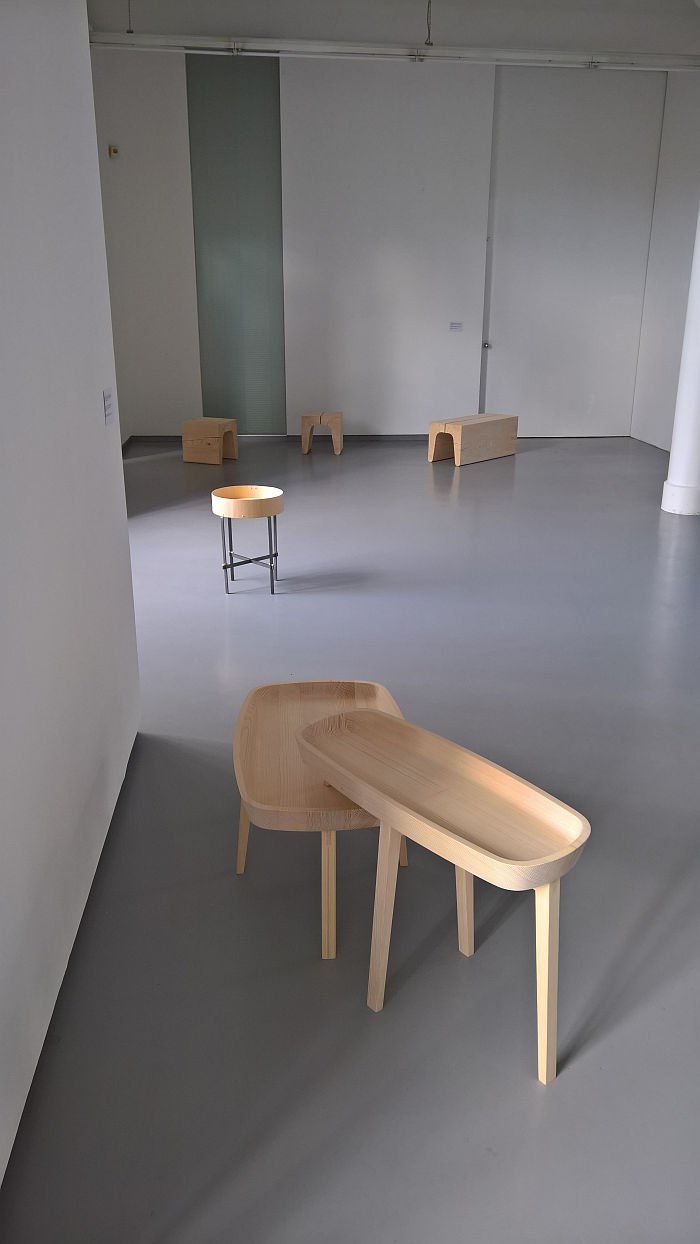
Interesting and engaging as the results of the project are, equally, arguably more, important is the process by which they arose, for all the dialogue between the craft practitioners and designers that formed the basis of the project, a dialogue important for the development, progress and evolution of furniture design, the discourse between the two allowing for new positions, new understandings, new solutions and thus new furniture.
And is a discourse that does regularly take place between craftsfolk, designers and furniture manufactures, or at least serious, interesting, design orientated manufacturers, and numerous commercial product lines are the result of such discourse and cooperations, including the, in many regards, Generation Köln trifft Bregenzerwald proto-project: Klemens Grund's D7 Chair & D7K Folding Chair for TECTA, realised in cooperation with, and produced, by Martin Bereuter.
A project such as Generation Köln trifft Bregenzerwald helps illuminate that process, helps underscore the interplay between craft and design, thereby allowing a differentiated public discussion on furniture design, one that moves away from the designer as a lone creative force and makes clear that furniture design is a process with numerous actors, a production that in addition to the designer features craftsfolk, artists, engineers, materials scientists, sociologists, psychiatrists, microbiologists etc, etc, etc and that meaningful, relevant, interesting design is the result of an honest discourse between those actors. Or perhaps put another way, a project such as Generation Köln trifft Bregenzerwald helps one approach an understanding of the role of the designer as a mediator between the various actors, helping fuse the disparate inputs into a meaningful object. Inputs which over time develop and evolve thereby demanding new consideration and reflection.
Which brings us back to the unity, the harmony, we spoke of above, a harmony, unity that, yes, does arise from the material, and also through the explorations of the material's properties and attributes, but is for all a positional harmony, unity: none of the works are new in the sense of being ground-breaking, genre redefining works, none of them are in your face challenges to convention, most of them will never have a life outwith Generation Köln trifft Bregenzerwald, or more accurately put, most of them will never have a life outwith Generation Köln trifft Bregenzerwald in their current form; however, as considerations on carpentry in contemporary furniture design worked through in an open discourse between carpenters and designers, as honest considerations on new ways of telling centuries old tales, all will feed into the understandings of the designers and thus, and whatever becomes of the physical object, the experiences that led to the objects will inform the protagonists future work and feed into the wider helix of furniture design.
Or put another way, and to link back to the previous Cologne design generation who exhibited in Bismarckstrasse 50, it isn't the works per se that are important, it's the reflections, understandings and positions inherent within.
Although that said, we will also be a little surprised, and mightily, mightily cross, if one or the other object doesn't have life outwith Generation Köln trifft Bregenzerwald........
Generation Köln trifft Bregenzerwald runs at Galerie Martina Kaiser, Bismarckstrasse 50 50672 Cologne until Sunday January 19th
Fuller information, and more images, including photos from Bregenzerwald and the work processes, can be found at www.instagram.com/generationkoeln
